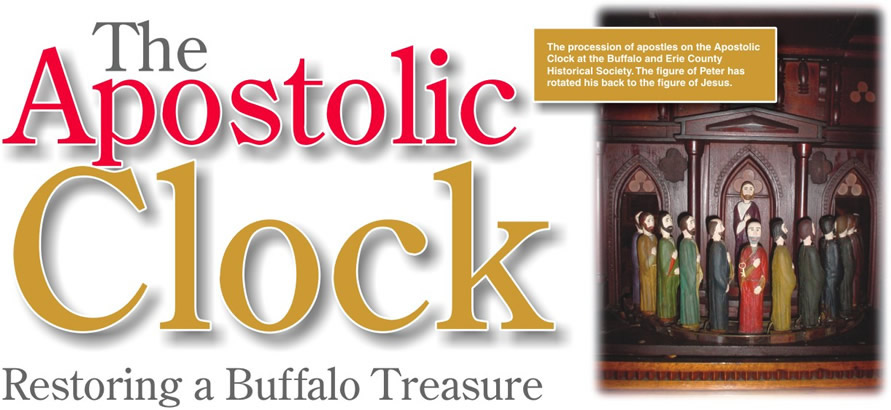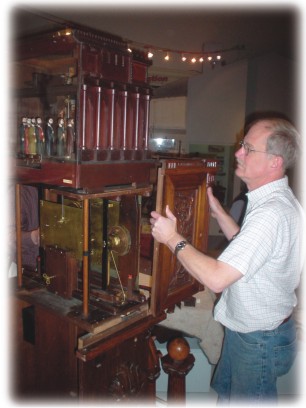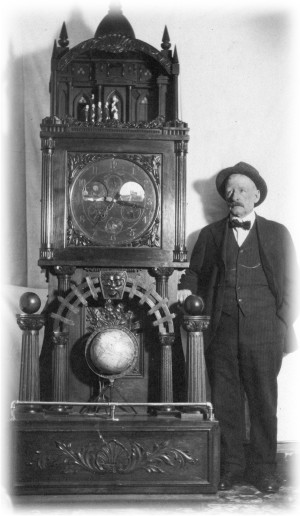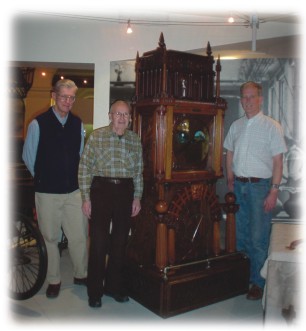


 By Jen Hyder
By Jen Hyder
The Easter season in Western New York features many traditions, such as stopping by at the Broadway Market, visiting churches on Holy Thursday, and celebrating Dyngus Day. Those who attend the marathon masses of Holy Week hear the biblical stories of Jesus’ arrival in Jerusalem, his Last Supper, his arrest and trial, his crucifixion on the cross, and his rise from the dead.
Part of the gospel on Good Friday involves the fulfillment of Jesus’ prophesy that Peter would deny knowing him three times before the rooster crows twice. For generations, many Buffalonians have associated this story with one of the Buffalo and Erie County Historical Society’s most treasured artifacts – the Apostolic Clock.
At 7 ½ feet and 400 pounds of hand-carved wood, the clock is a wonder of craftsmanship throughout, but its most impressive feature is at the top. With the striking of every half-hour, a bell tolls and a procession of Apostle figurines commences around a centrally located figure of Jesus. Each Apostle turns and bows his head to Christ as he passes. The lone exception is the figure of Peter, who rotates his back to Jesus. At the same time, the Latin words Deum Non Cognosco appear, meaning, “He denies the Savior.”
The Apostolic Clock has been on display at the Historical Society since 1923, when Buffalo native Myles Hughes donated a life's work for the enjoyment of the community. Mr. Hughes, who was considered an amateur clockmaker, began working on this clock in 1881, during what he called some “spare moments.” He spent thirty-five years creating his masterpiece in a shed behind his house.
Mr. Hughes incorporated four different types of wood into the clock. The upper part is cedar, the middle is mahogany and cherry, and the lower part is made from oak. The clock's face is a brass dial with engraved numerals filled with wax. It also features dials that show the seconds, days of the week, months of the year, the phases of the moon, and the rising and setting of the sun. At the front of the clock sits a globe that rotates.
In recent years, the Apostolic Clock has been out of working order, but thanks to three local gentlemen following in Mr. Hughes’ footsteps, the “spare moments” tradition continues. Marv DeBoy, Chris Tahk, Ph.D., and Fred Robjent, who are all members of the National Association of Watch and Clock Collectors, have dedicated several months to restoring this historic Buffalo timepiece. Of the three men, Mr. DeBoy has the most experience working on the clock. A former project engineer at Bell Aircraft, he first volunteered to work on the Apostolic Clock in 1974. It was at that time that Mr. DeBoy discovered that earlier restoration attempts had been conducted with varying levels of expertise. This presented a unique problem when it came to determining what Myles Hughes’ original work was, and what had been done as repairs in later years.
Dr. Tahk was a professor at Kent State and the University of Rochester before becoming the director of the Art Conservation Program at Buffalo State College, a position he held until his retirement in 2004. Prior to his retirement, the Historical Society had approached him to work on the clock, but Dr. Tahk chose to wait until he had more time to commit to the project – in 2008, he decided that the time was right.
Mr. Robjent worked for Fisher Price Toys, with a background in mechanical engineering. He originally learned about the clock through friends and was later asked by Dr. Tahk to help with the restoration, which took place in a spare bedroom of his home.
The three men made many improvements to the clock, including adding a weight level indicator to help prevent the cables from breaking during winding. They also restored the clock face, adjusted the hour striking mechanism and reconstructed the globe rotation device. The original globe is currently under restoration at Buffalo State College's Art Conservation Department.
The Apostolic Clock was recently reinstalled in the Historical Society's museum. The restoration team still has a few more repairs to make to it, but they expect the clock to be running again later this spring. The clock sits in the museum's Buffalo Made exhibit, which houses over 700 items that were either invented or produced in Buffalo, ranging from Cheerios to the cardiac Pacemaker.
Also currently on display at the museum is the work of South Buffalo native Dr. V. Roger Lalli, who used his own “spare moments” to create a magnificent tribute of Buffalo. Beginning in 1989, at the age of 67, Dr. Lalli committed the next ten years of his life to painting a series of photorealistic watercolors titled Buffalo My City. This collection takes the viewer on a tour of 42 of Buffalo's most beloved landmarks, including the Market Arcade Building, Shea's Performing Arts Center and the Albright-Knox Art Gallery. These paintings are on display at the Historical Society through May 31.
To view the Apostolic Clock, visit the Historical Society at 25 Nottingham Court at Elmwood Avenue in Buffalo. Hours are Tuesday through Saturday from 10 a.m. to 5 p.m. and Sunday from noon to 5 p.m. Admission is $6 for adults, $4 for students ages 13 to 21 and seniors ages 60 and older, $2.50 for ages 7 to 12, and free for Historical Society members and children under 6. For more information please call (716) 873-9644 or visit www.buffalohistory.org.
Jen Hyder will graduate from Canisius College in May with a bachelor's degree. She is a communications intern at the Buffalo and Erie County Historical Society. She can be reached at bechs@bechs.org.


